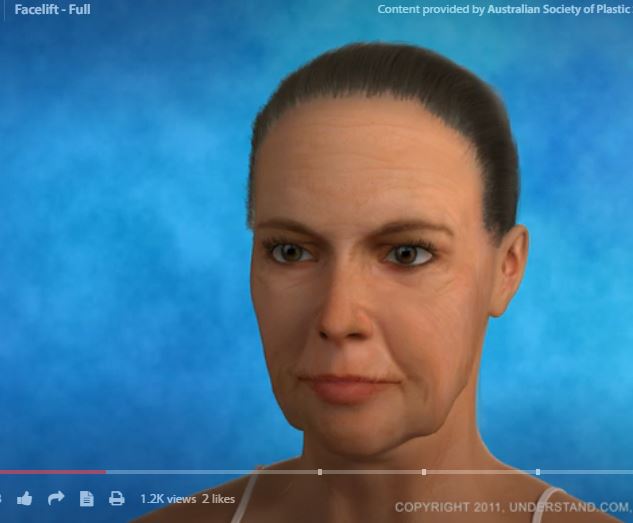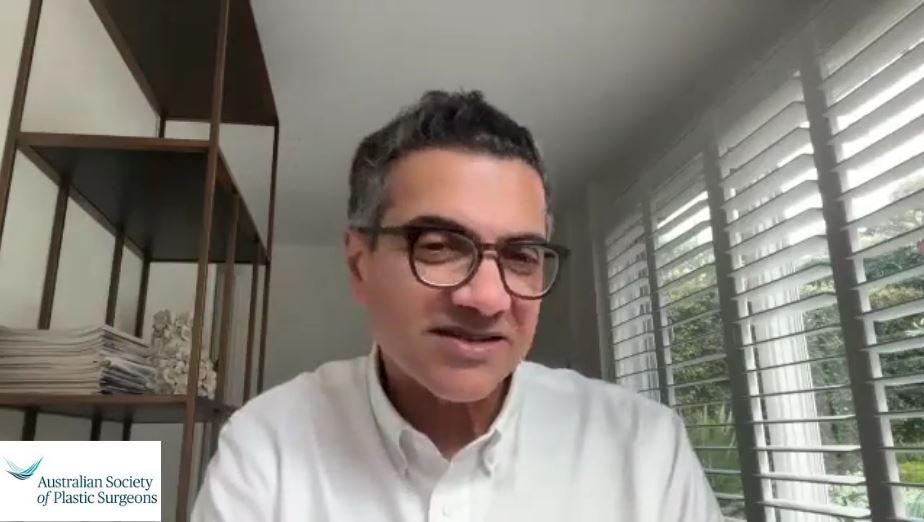Procedures
Facelift Surgery
- About Your Specialist Plastic Surgeon
- Cosmetic
- Non-surgical Procedures
- Plastic Surgery Glossary
- Questions for Your Surgeon
- Reconstructive
- Surgical Procedures
- Abdominoplasty (cosmetic)
- Abdominoplasty (muscle repair postpartum)
- Arm Lift
- Body Contouring
- Body Lift
- Breast Asymmetry Correction
- Breast Augmentation (implants)
- Breast Implants with Lift
- Breast Lift
- Breast Reconstruction
- Breast Reduction
- Brow Lift
- Burns and Scarring
- Chest Surgery
- Chin Surgery
- Cleft Lip & Palate
- Ear Surgery
- Eyelid Reduction Surgery
- Facelift Surgery
- Facial Implants
- Facial Procedures
- Fat Injection
- Genital Reconfiguration Surgery
- Gluteal Augmentation or Buttocks Lift
- Gynaecomastia (male breast reduction)
- Hair Replacement Surgery
- Hand Surgery
- Labiaplasty
- Liposuction
- Lymphoedema Surgery
- Nipple Enhancement for Inverted Nipples
- Nose Surgery
- Scar Revision
- Skin Cancer
- Thigh Lift
- Tissue Expansion
- Voice Surgery
Facelift Surgery
Any surgical or invasive procedure carries risks. Before proceeding, you should seek a second opinion from an appropriately qualified health practitioner.
A facelift, also known as meloplasty or rhytidectomy, is a surgical procedure that tightens and removes sagging skin on the face and neck. Facial muscles may be surgically tightened to improve their tone. Excess fat may also be removed or repositioned as part of the surgery.
Most facelifts are performed for people aged between 40 and 65, but older people can also have facelifts.
The aim of a facelift is to reduce the signs of ageing by improving the contours of the face and neck. A facelift can help to make the face and skin appear younger and smoother. A facelift may also be combined with other surgical procedures such as a brow lift, eyelid surgery or nose reconstruction. The bone structure of the face will not be changed during facelift surgery.
Non-surgical treatments, such as chemical skin peel , dermabrasion or skin resurfacing of the face, may be undertaken at the same time as the facelift. The aim of these treatments is to treat sun-damaged skin and crow’s feet around the eyes, and fine lines around the mouth, which are not removed by facelift surgery.
Facelift surgery is a highly individualised procedure and may not be suitable for everyone. Always talk to your Specialist Plastic Surgeon before making a decision. Your surgeon will assess your condition and general health, and plan the treatment that is best suited to you.
Before you decide on facelift surgery, there are some important issues to keep in mind:
- While a facelift should make you look younger, it will not raise sagging eyebrows, remove deep frown lines in the forehead, change your upper or lower eyelids, or get rid of wrinkles around the mouth. Other forms of treatment may be more appropriate for you
- Suture facelift, or thread lifting, is best suited for younger and middle-aged patients whose tissues have sagged with time or sun damage. It is not recommended for people with very thin or dry skin. Your surgeon will need to assess your individual suitability for this type of treatment
- The results of a facelift usually last between five and twelve years. Most people can have two to three facelifts in a lifetime, depending on the extent of each procedure and the amount of scarring that occurs with each facelift
- Facelift surgery does not “stop the clock” of ageing. The normal ageing process will continue after the surgery
- Smokers are at increased risk of complications. If you are serious about undergoing surgery, you should quit smoking
Facelift surgery may not be a good option for you if you are:
- Not able to have an anaesthetic
- Prone to bleeding tendencies or have poor healing ability
- Too high risk of having surgical complications
Facelift surgery may be a good option for you if:
- You have sagging in the mid-face
- You have deep creases below the lower eyelids
- You have deep creases along the nose extending to the corner of the mouth
- You have fat that has fallen or is displaced
- You have loss of muscle tone in the lower face which may create jowls
- You have loose skin and excess fatty deposits under the chin and jaw, creating the appearance of a double chin
- You are physically healthy and you do not have medical conditions that can impair healing or increase risk of surgery
- You have realistic expectations of what face lift surgery can accomplish
- You are a non-smoker or have stopped smoking
Modern surgery is generally safe but does have the potential for risks and complications to occur.
Some general risks and complications of surgery may include:
- Heavy bleeding from an operated site
- Infection that may require treatment with antibiotics or further surgery in some cases
- Allergic reaction to sutures, dressings or antiseptic solutions
- The formation of a large blood clot (haematoma) beneath an incision site that may require drainage
- Pain, bruising and swelling around the operated site(s)
- Keloids and hypertrophic scars that are raised, red and thickened scars that may form over the healed incisions. These may be itchy, annoying and unsightly but are not a threat to health
- Slow healing, often related to smoking or diabetes
- Separation of wound edges
- Short-term nausea following general anaesthesia and other risks related to anaesthesia
Specific risks and complications associated with facelift surgery include:
- Hair loss around the scars, this is usually temporary but sometimes may be permanent
- Loss of skin due to impaired blood supply. This may require a skin graft
- Bruising and swelling
- Numbness around operated sites. In most cases this is temporary and will improve over many months
- Deformity of the earlobe
- Slight difference in appearance between the right and left side of the face
- Damage to the facial nerve, which occurs in about one in every one hundred patients. It can result in partial loss of movement and a “lopsided” appearance of the face. In rare cases, the damage may be permanent
- Revisional surgery may be necessary to correct complications
Depending upon your general health and the extent of the procedure, facelift surgery can be performed either as a day case or alternatively with a short hospital stay. Your Specialist Plastic Surgeon will advise on the best option for you.
Before undergoing surgery, it is important that you:
- Be as fit as possible to help the recovery process
- Check with your surgeon about your medications as some may need to be stopped
- Stop smoking
You will also be asked to provide a complete medical history for your Specialist Plastic Surgeon including any health problems you have had, any medication you are taking or have taken, and any allergies you may have.
You may be advised to stop taking certain medicines such as non-steroidal anti-inflammatory drugs (NSAIDs), aspirin, and medicines that contain aspirin. You may also be asked to stop taking naturopathic substances such as garlic, ginkgo, ginseng and St John’s Wort as they may affect clotting and anaesthesia. Always tell your surgeon EVERYTHING you are taking.
Unless your surgeon advises differently, you will be able to continue taking most medicines that you have been taking.
Your surgeon will also advise you if any other tests are required, such as blood tests, X-ray examinations or an Electrocardiograph (ECG) to assess your heart.
If you decide to have facelift surgery, your surgeon will ask you to sign a consent form. Make sure you read the consent form carefully before signing. If you have any questions, ask your surgeon.
Prepare a “recovery area” in your home. This may include pillows, ice packs, a thermometer and a telephone within easy reach. Make sure you arrange for a relative or friend to drive you to and from the hospital or clinic. Someone should also stay with you for at least 24 hours after you return home.
Your surgeon should give detailed preoperative instructions. Follow them carefully.
Arrange for a relative or friend to drive you home after the surgery. Someone should also stay with you for at least the first day after the operation and preferably for a few days.
If you experience any of the following symptoms, notify your surgeon immediate:
- Temperature higher than 38°C or chills
- Heavy bleeding from the incisions
- Worsening redness around the incision sites
- Increasing pain or tenderness, or other problems that appear to be worsening
You can usually drink fluids and eat a light meal two or three hours after surgery. You may have some pain and discomfort, particularly around the incisions. Your Specialist Plastic Surgeon will prescribe pain medication as required.
In some cases, a small, thin tube may be temporarily placed under the skin to drain any excess blood or fluid that may collect.
Some bruising and swelling is normal, and may take up to a few weeks to disappear. Sleeping with your head elevated will help to reduce the swelling.
Depending on the extent of your procedure, you may need to take a few weeks off work to rest. Avoid heavy lifting, strenuous exercise, swimming and strenuous sports until advised by your surgeon.
Your surgeon will give you specific instructions on post-operative care. These instructions may include:
- How to care for your surgical site(s) following surgery
- Medications to apply or take orally to aid healing and reduce the risk of infection
- Specific concerns to look for at the surgical site(s) or in your general health
- When to follow-up with your surgeon
Be sure to ask your surgeon specific questions about what you can expect during your individual recovery period, such as:
- Where will I be taken after my surgery is complete?
- What medication will I be given or prescribed after surgery?
- Will I have dressings/bandages after surgery? If so, when will they be removed?
- Are stitches removed? When will they be removed?
- When can I resume normal activity and exercise?
- When do I return for follow-up care?
Scars are an inevitable part of any invasive surgery. Your Specialist Plastic Surgeon will endeavour to minimise scarring and to keep your scars as inconspicuous as possible by locating the incisions in easily hidden sites. That way, scars will be along natural skin lines and creases. Scars may fade with time and become barely noticeable. If you are prone to scarring, you should advise your surgeon.
As with all surgical procedures, revisional surgery may be necessary to correct minor irregularities. The results of a facelift usually lasts between five and twelve years. Most people can have two to three facelifts in a lifetime, depending on the extent of each procedure and the amount of scarring that occurs with each facelift.
Cost is always a consideration in elective surgery. Prices for a facelift can vary widely between Specialist Plastic Surgeons. Some factors that may influence the cost include the surgeon’s experience, the type of procedure used and the geographic location of the office.
Costs associated with the procedure may include:
- Surgeon’s fee
- Hospital or surgical facility costs
- Anaesthesia fees
- Prescriptions for medication
- Post-surgery garments
- Medical tests
Your surgeon should welcome any questions you may have regarding fees.
General anaesthesia:
Drugs and/or gases used during an operation to relieve pain and alter consciousness
Hematoma:
Blood pooling beneath the skin
Intravenous sedation:
Sedatives administered by injection into a vein to achieve relaxation
Jowls:
A jaw line that sags into the neck, usually caused by loss of muscle tone in the lower face
Local anaesthesia:
A drug injected directly to the site of an incision during an operation to relieve pain
Meloplasty:
Facelift surgery
Nasolabial fold:
Deep creases between the nose and cheek
Rhytidectomy:
A surgical procedure also known as facelift, to reduce sagging of the mid-face, jowls and neck
Tear trough:
Deep creases below the lower eyelids
Visit the Plastic Surgery Glossary for more medical terms.
This website is intended to provide you with general information only. This information is not a substitute for advice from your Specialist Plastic Surgeon and does not contain all the known facts about this procedure or every possible side effect of surgery. It is important that you speak to your surgeon before deciding to undergo surgery. If you are not sure about the benefits, risks and limitations of treatment, or anything else relating to your procedure, ask your surgeon to explain. Patient information provided as part of this website is evidence-based, and sourced from a range of reputable information providers including the American Society of Plastic Surgeons, Better Health Channel and Mi-tec medical publishing.
Featured Stories

ASPS welcomes new Ahpra guidelines for Non-Surgical Cosmetic Practitioners
Sydney. June 3, 2025: The Australian Society of Plastic Surgeons…
Continue reading


